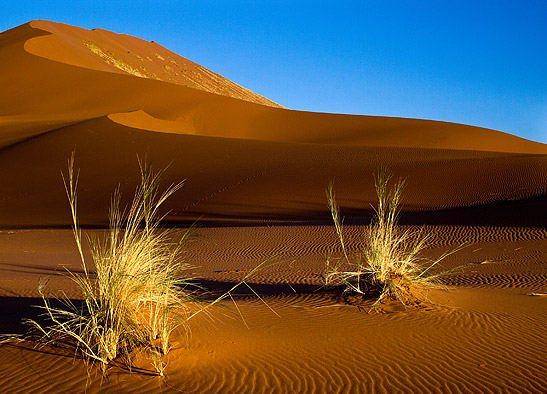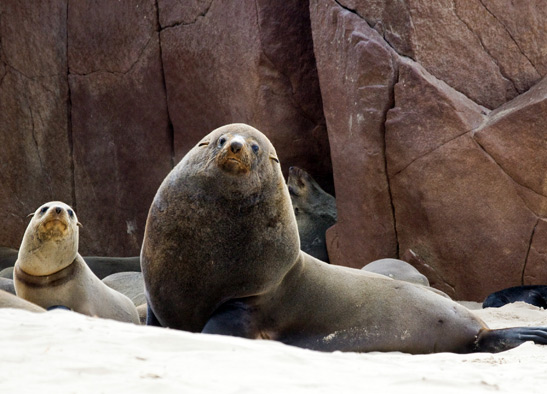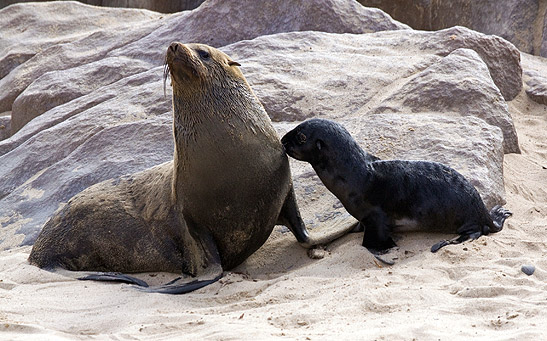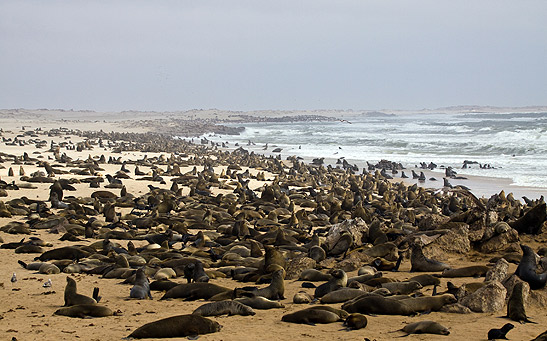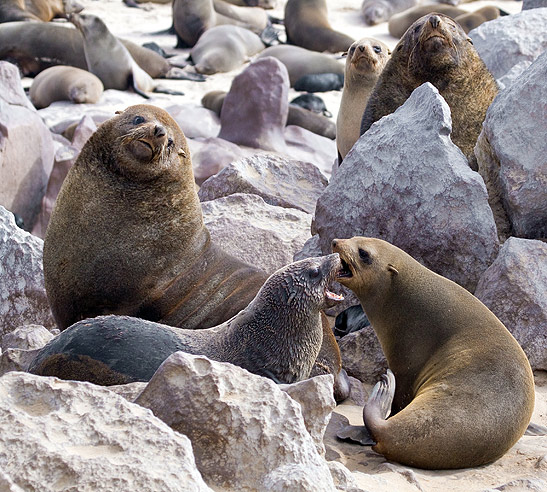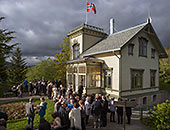 |
 |
|
 |

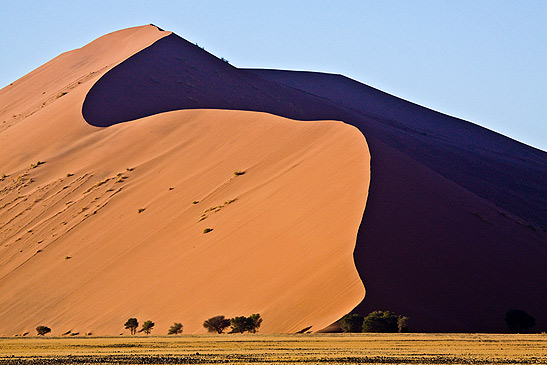
Namibia:
The country is located on the southwest coast of Africa and is named after The Namib, a 1200-mile-long stretch of real estate where scorching desert in stunning contrast overlaps frigid sea, and water, wind, sand and sun play off each other to create a unique visual landscape that challenges the most versatile of photographers. The desert, home to the highest sand dunes in the world, parallels the Skeleton Coast, so named in honor of the many wrecked ships and sailors’ lives lost over centuries. The latter also is home to hundreds of thousands of seals but despite their close proximity, rarely do the seals climb the dunes.
Our sunrise ascent of the dunes, rust in color, smooth in texture, mountainous in size, and other-worldly in nature, was part of many such excursions on our Overseas Adventure Travel (OAT) tour, where the daily mantra of our guide, Bhavi, focused on “learning and discovery.” But more on that later. First, from the summit we watched the early sunlight dancing on the dunes to the tune of orange, pink, tan, yellow and gray-colored notes. Later, flying in a small plane above a wider panorama, the dunes more resembled frothy peaks of pink meringue covering the countryside, and the sensuous gradations, indentations and undulations created by the shadows playing off those soft swirls of desert icing added as much to this visual feast as has the sweet geology of time. My fellow travelers on the tour, all OAT veterans and intrepid adventurers, came to Namibia in part because it was virgin tourist territory. Mary Jo McDonald of Madison, Wisconsin touted the trip as “Exactly what I expected. It was full of adventure, exposure to under-developed areas with wildlife different from my other trips.” And she added: “I came primarily to see the dunes and they didn’t disappoint. I loved climbing them at sunrise and seeing them in such terrific light.” The first thing you notice upon arrival at the Cape Cross Fur Seal Reserve, one of about 25 colonies along the Skeleton Coast and the only one accessible to the public, is a slightly pungent acrid odor. That greeting is followed by a modest barking sound, the level of which increases greatly as you approach further. As the general din breaks down into honking, wheezing, coughing, whining, braying, cackling, and bleating, and the small black dots begin to take shape as they lumber across the rocks, I wondered: “How can so many of the same species make so many different sounds?”
What first seemed like just a clamor of sounds then take on a more emotional content: The racket emanating from the mass of slippery humanity below? Sorrowful, belligerent, questioning, anxious, soulful. As I pondered their fierce existence -- frigid waters, rocky shore, crowded conditions -- I thought, “No wonder their cries are so mournful…”
The throngs of thousands are animated. Some seals brave the rough waters of the Atlantic, others settle for sunbathing; mothers tend to their pups, teens engage in rough ‘n tumble frolic, a bull or two seem to have what appears to be some words with each other. While I was mesmerized by the sea lions, the birdwatcher next to me was trying to determine whether it was a ruddy turnstone or an orange-legged ruff running along the surf. Avid birdwatchers are a species all to their own.
I felt like a Peeping Tom overlooking massive gray communities of seals and stones merging together in a surreal setting. Outside one large boulder condo unit, a fiery male ferociously defends his territory. A little further away, some parents and their children are out for a stroll -- albeit a somewhat bumpy one. Down another (decidedly) rocky road, a handsome young stud seemingly flirts with several females at once. Hmmm -- perhaps not so different a social venue than our own. Our OAT guide, who didn’t shy away from controversial topics –- a very unusual trait among tour guides -– told us that clubbing of the young is still used as a means of depleting the number of seals, seen by fisherman as a threat to their livelihood. As evidence builds that it’s more the humans than the seals that are responsible for the lower fish supply, it is hoped that the practice of culling will recede. Another “learning and discovery” moment. But there is a lot more to recommend this unusual country than just its western coastline; the culture of its people and its wildlife offer visitors a whole other dimension to appreciate. More of that in Namibia Part II. If You Go Groups are small, the hotels and game lodges where we stayed range from comfortable to luxurious, and our guides were excellent. I also like the fact that OAT undertakes charitable activities in countries in which it offer trips. OAT offers land trips around the world, as well as small ship cruises. Prices begin at $1,895, for a visit to Costa Rica. The 18-day Namibia trip starts at $4995. For more information, visit Oatravel.com or call (800) 955-1925. (Posted
11-11-2010) |
|
|
| |||
This site is designed and maintained by WYNK Marketing. Send all technical issues to: support@wynkmarketing.com

|






